Accounting & Financial Management - Desklib
VerifiedAdded on 2023/06/10
|12
|2413
|198
AI Summary
This article discusses the evaluation of projects using NPV and IRR, and their limitations. It includes a detailed analysis of two projects, their discount rates, cash flows, payback periods, and profitability index. The article also highlights the advantages and disadvantages of using IRR and NPV, and their suitability for different types of projects. The subject is Accounting & Financial Management, and the article is relevant for students pursuing courses in this field.
Contribute Materials
Your contribution can guide someone’s learning journey. Share your
documents today.
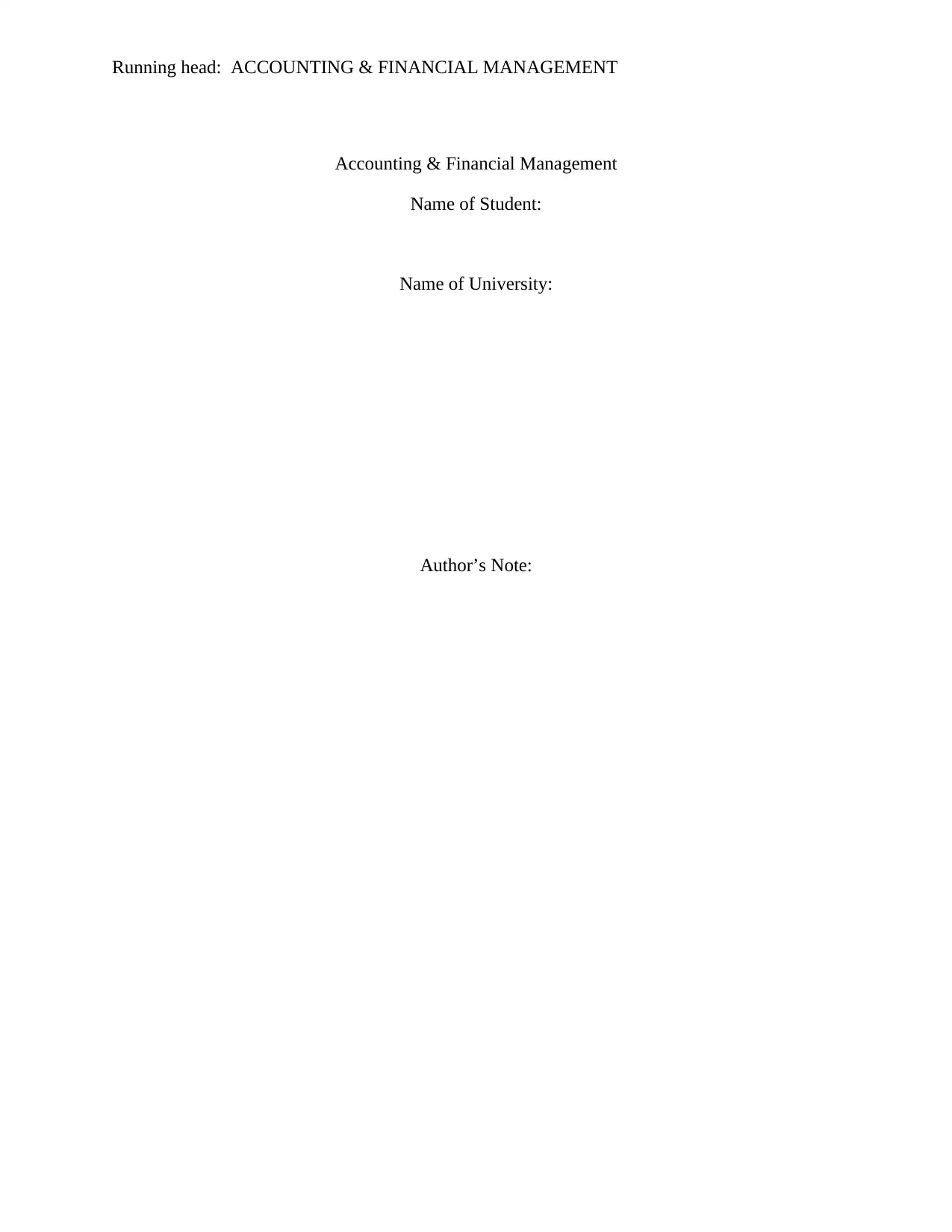
Running head: ACCOUNTING & FINANCIAL MANAGEMENT
Accounting & Financial Management
Name of Student:
Name of University:
Author’s Note:
Accounting & Financial Management
Name of Student:
Name of University:
Author’s Note:
Secure Best Marks with AI Grader
Need help grading? Try our AI Grader for instant feedback on your assignments.
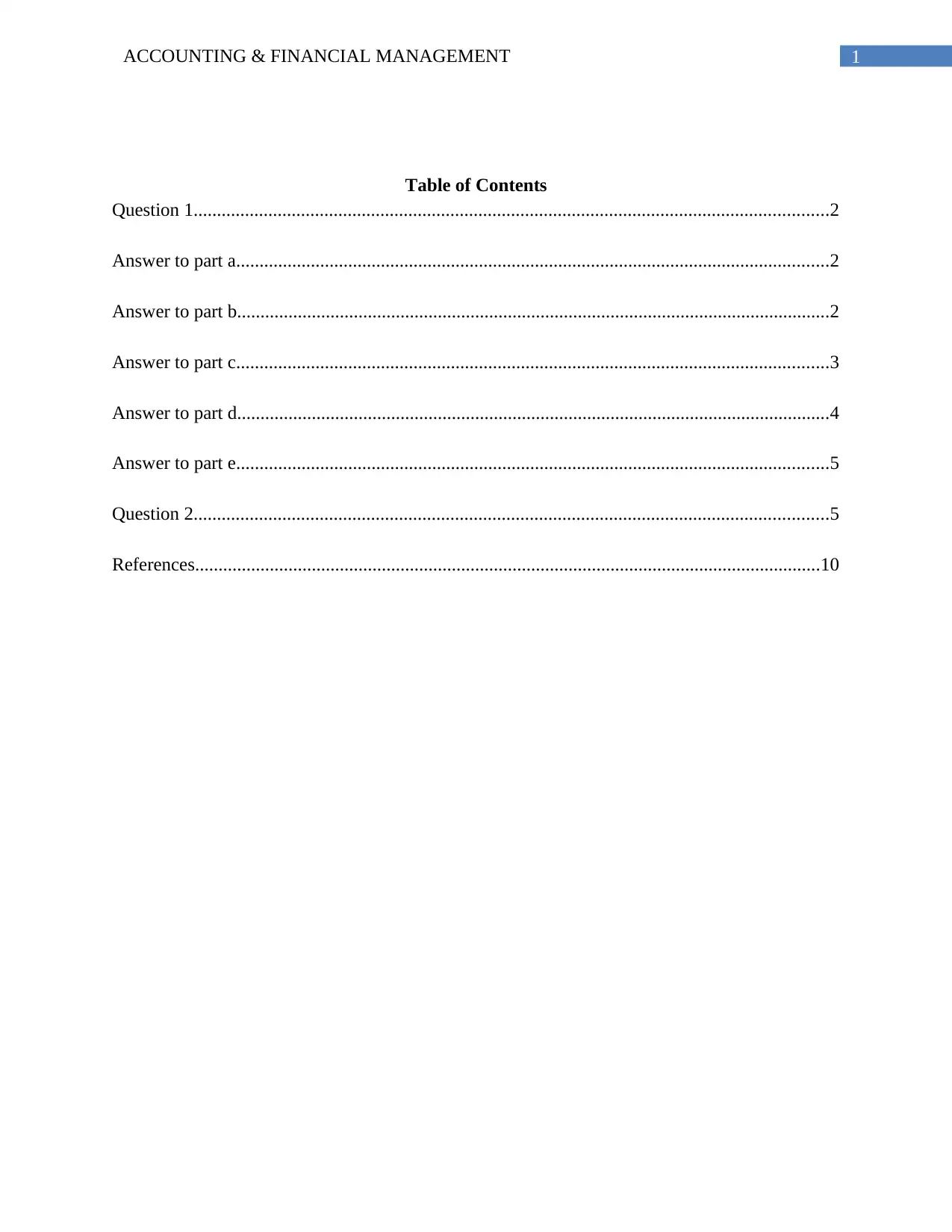
1ACCOUNTING & FINANCIAL MANAGEMENT
Table of Contents
Question 1........................................................................................................................................2
Answer to part a...............................................................................................................................2
Answer to part b...............................................................................................................................2
Answer to part c...............................................................................................................................3
Answer to part d...............................................................................................................................4
Answer to part e...............................................................................................................................5
Question 2........................................................................................................................................5
References......................................................................................................................................10
Table of Contents
Question 1........................................................................................................................................2
Answer to part a...............................................................................................................................2
Answer to part b...............................................................................................................................2
Answer to part c...............................................................................................................................3
Answer to part d...............................................................................................................................4
Answer to part e...............................................................................................................................5
Question 2........................................................................................................................................5
References......................................................................................................................................10
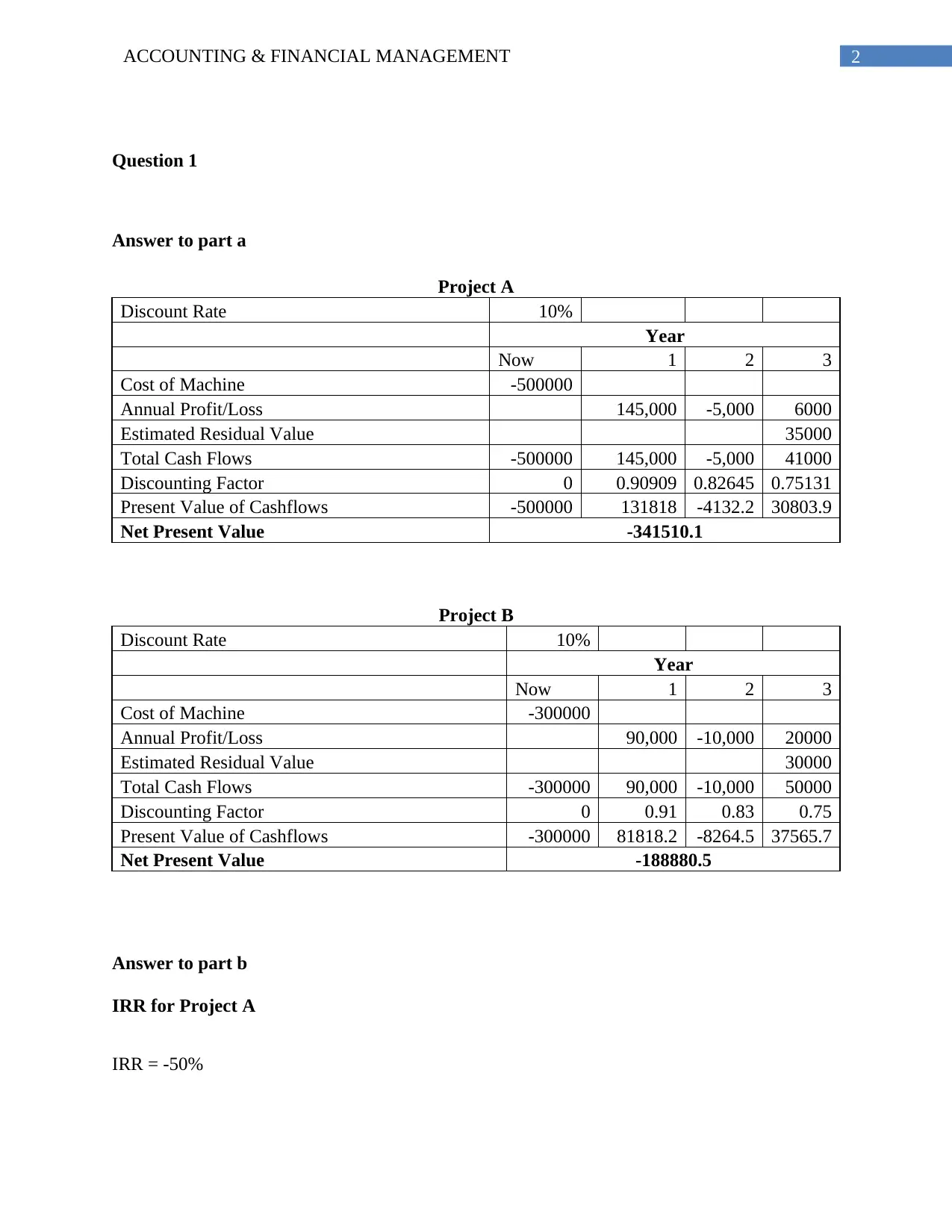
2ACCOUNTING & FINANCIAL MANAGEMENT
Question 1
Answer to part a
Project A
Discount Rate 10%
Year
Now 1 2 3
Cost of Machine -500000
Annual Profit/Loss 145,000 -5,000 6000
Estimated Residual Value 35000
Total Cash Flows -500000 145,000 -5,000 41000
Discounting Factor 0 0.90909 0.82645 0.75131
Present Value of Cashflows -500000 131818 -4132.2 30803.9
Net Present Value -341510.1
Project B
Discount Rate 10%
Year
Now 1 2 3
Cost of Machine -300000
Annual Profit/Loss 90,000 -10,000 20000
Estimated Residual Value 30000
Total Cash Flows -300000 90,000 -10,000 50000
Discounting Factor 0 0.91 0.83 0.75
Present Value of Cashflows -300000 81818.2 -8264.5 37565.7
Net Present Value -188880.5
Answer to part b
IRR for Project A
IRR = -50%
Question 1
Answer to part a
Project A
Discount Rate 10%
Year
Now 1 2 3
Cost of Machine -500000
Annual Profit/Loss 145,000 -5,000 6000
Estimated Residual Value 35000
Total Cash Flows -500000 145,000 -5,000 41000
Discounting Factor 0 0.90909 0.82645 0.75131
Present Value of Cashflows -500000 131818 -4132.2 30803.9
Net Present Value -341510.1
Project B
Discount Rate 10%
Year
Now 1 2 3
Cost of Machine -300000
Annual Profit/Loss 90,000 -10,000 20000
Estimated Residual Value 30000
Total Cash Flows -300000 90,000 -10,000 50000
Discounting Factor 0 0.91 0.83 0.75
Present Value of Cashflows -300000 81818.2 -8264.5 37565.7
Net Present Value -188880.5
Answer to part b
IRR for Project A
IRR = -50%
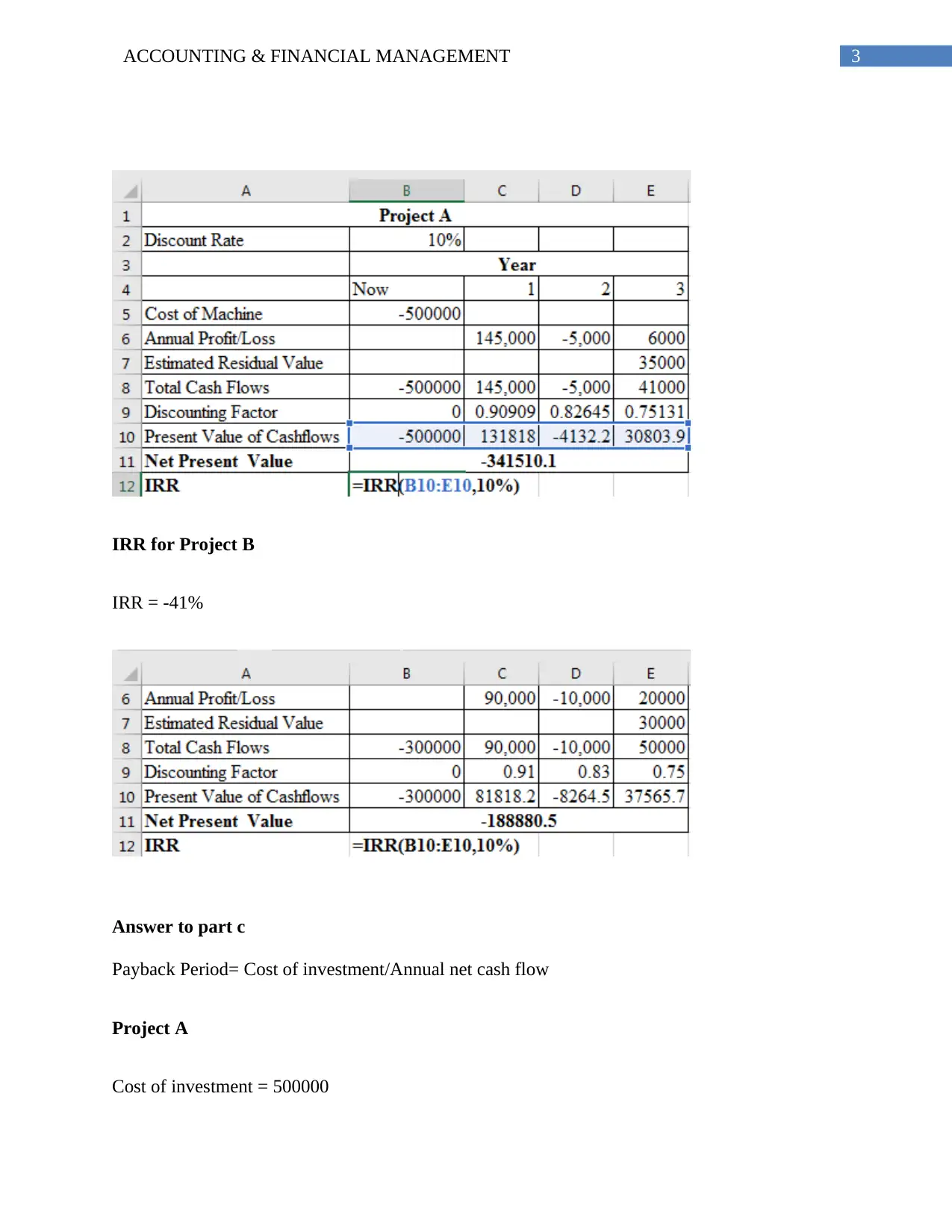
3ACCOUNTING & FINANCIAL MANAGEMENT
IRR for Project B
IRR = -41%
Answer to part c
Payback Period= Cost of investment/Annual net cash flow
Project A
Cost of investment = 500000
IRR for Project B
IRR = -41%
Answer to part c
Payback Period= Cost of investment/Annual net cash flow
Project A
Cost of investment = 500000
Secure Best Marks with AI Grader
Need help grading? Try our AI Grader for instant feedback on your assignments.
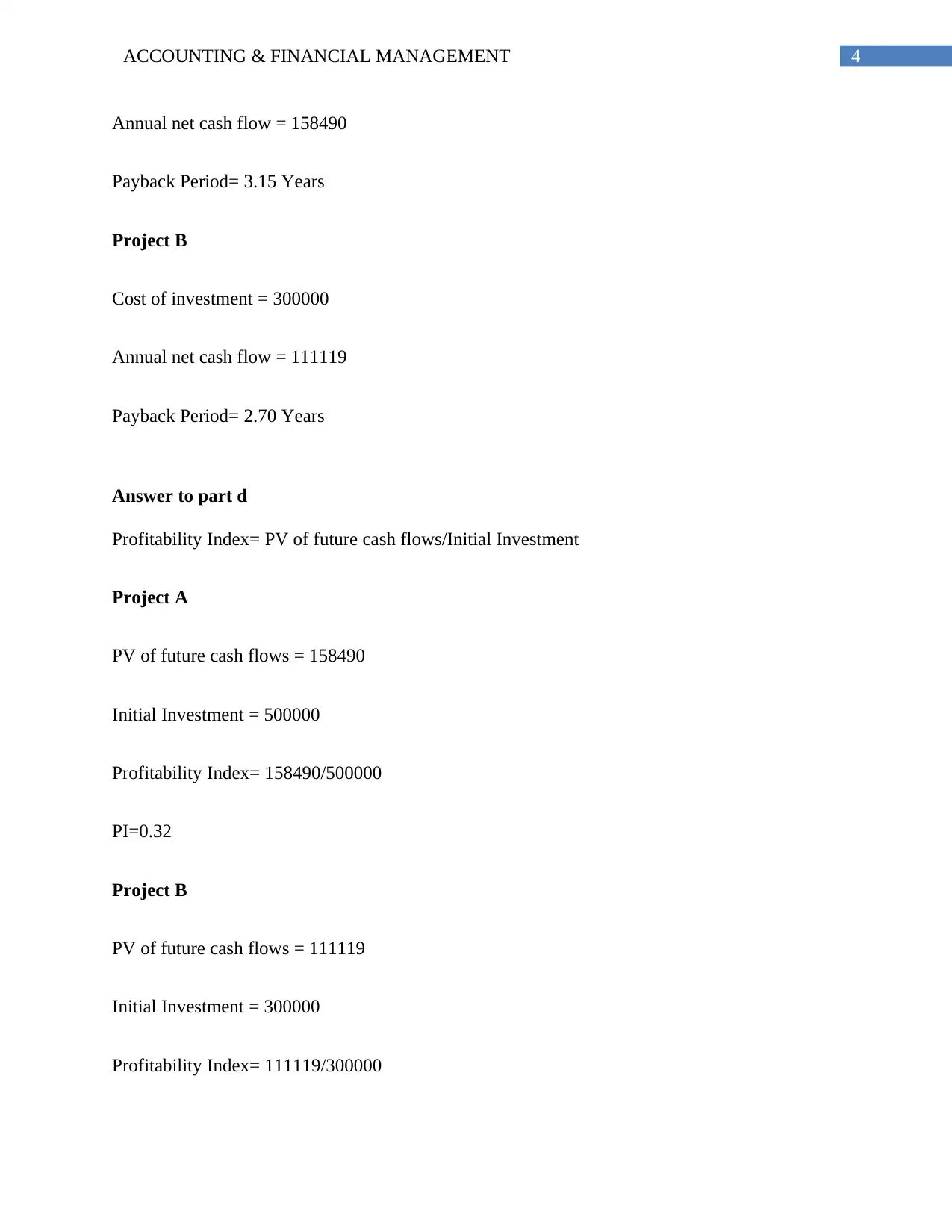
4ACCOUNTING & FINANCIAL MANAGEMENT
Annual net cash flow = 158490
Payback Period= 3.15 Years
Project B
Cost of investment = 300000
Annual net cash flow = 111119
Payback Period= 2.70 Years
Answer to part d
Profitability Index= PV of future cash flows/Initial Investment
Project A
PV of future cash flows = 158490
Initial Investment = 500000
Profitability Index= 158490/500000
PI=0.32
Project B
PV of future cash flows = 111119
Initial Investment = 300000
Profitability Index= 111119/300000
Annual net cash flow = 158490
Payback Period= 3.15 Years
Project B
Cost of investment = 300000
Annual net cash flow = 111119
Payback Period= 2.70 Years
Answer to part d
Profitability Index= PV of future cash flows/Initial Investment
Project A
PV of future cash flows = 158490
Initial Investment = 500000
Profitability Index= 158490/500000
PI=0.32
Project B
PV of future cash flows = 111119
Initial Investment = 300000
Profitability Index= 111119/300000
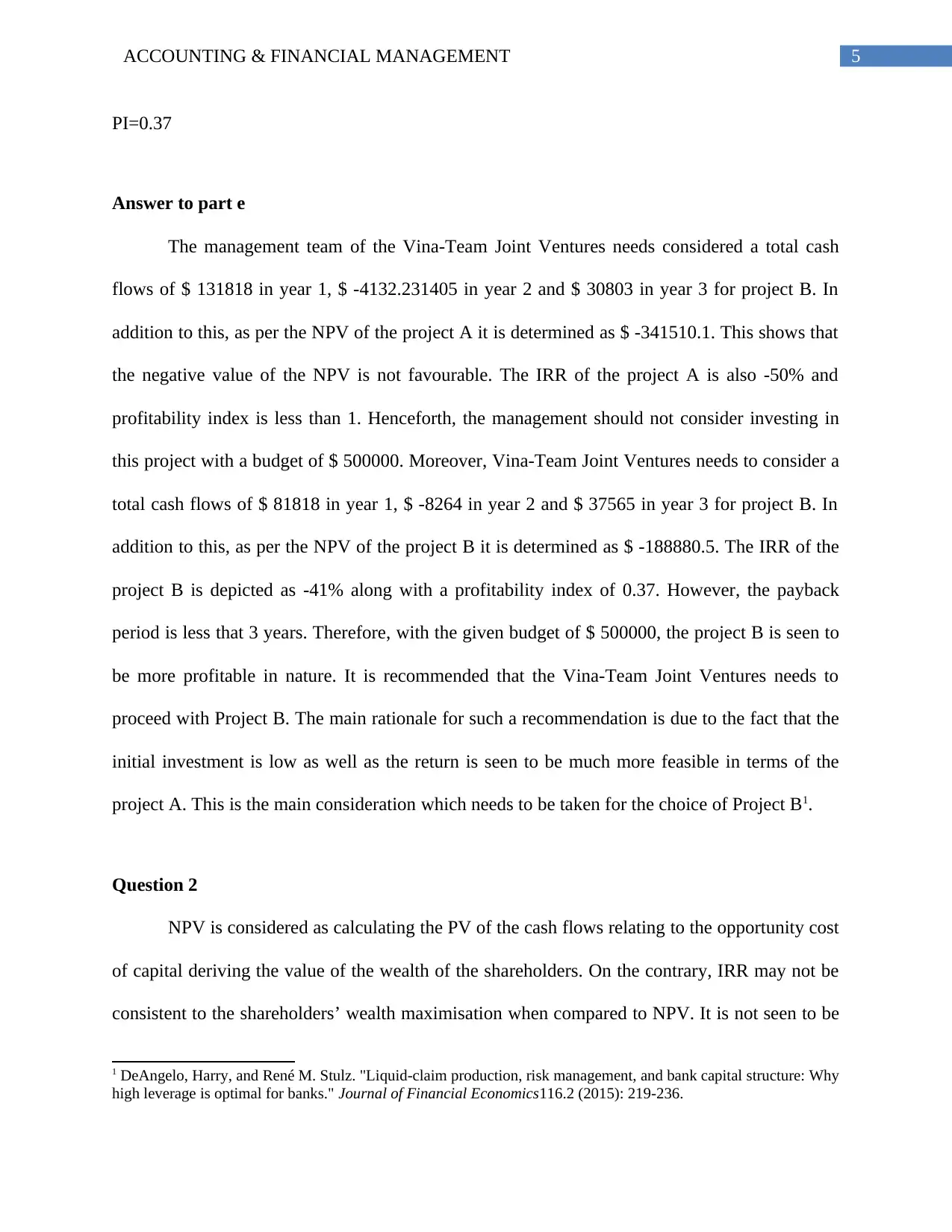
5ACCOUNTING & FINANCIAL MANAGEMENT
PI=0.37
Answer to part e
The management team of the Vina-Team Joint Ventures needs considered a total cash
flows of $ 131818 in year 1, $ -4132.231405 in year 2 and $ 30803 in year 3 for project B. In
addition to this, as per the NPV of the project A it is determined as $ -341510.1. This shows that
the negative value of the NPV is not favourable. The IRR of the project A is also -50% and
profitability index is less than 1. Henceforth, the management should not consider investing in
this project with a budget of $ 500000. Moreover, Vina-Team Joint Ventures needs to consider a
total cash flows of $ 81818 in year 1, $ -8264 in year 2 and $ 37565 in year 3 for project B. In
addition to this, as per the NPV of the project B it is determined as $ -188880.5. The IRR of the
project B is depicted as -41% along with a profitability index of 0.37. However, the payback
period is less that 3 years. Therefore, with the given budget of $ 500000, the project B is seen to
be more profitable in nature. It is recommended that the Vina-Team Joint Ventures needs to
proceed with Project B. The main rationale for such a recommendation is due to the fact that the
initial investment is low as well as the return is seen to be much more feasible in terms of the
project A. This is the main consideration which needs to be taken for the choice of Project B1.
Question 2
NPV is considered as calculating the PV of the cash flows relating to the opportunity cost
of capital deriving the value of the wealth of the shareholders. On the contrary, IRR may not be
consistent to the shareholders’ wealth maximisation when compared to NPV. It is not seen to be
1 DeAngelo, Harry, and René M. Stulz. "Liquid-claim production, risk management, and bank capital structure: Why
high leverage is optimal for banks." Journal of Financial Economics116.2 (2015): 219-236.
PI=0.37
Answer to part e
The management team of the Vina-Team Joint Ventures needs considered a total cash
flows of $ 131818 in year 1, $ -4132.231405 in year 2 and $ 30803 in year 3 for project B. In
addition to this, as per the NPV of the project A it is determined as $ -341510.1. This shows that
the negative value of the NPV is not favourable. The IRR of the project A is also -50% and
profitability index is less than 1. Henceforth, the management should not consider investing in
this project with a budget of $ 500000. Moreover, Vina-Team Joint Ventures needs to consider a
total cash flows of $ 81818 in year 1, $ -8264 in year 2 and $ 37565 in year 3 for project B. In
addition to this, as per the NPV of the project B it is determined as $ -188880.5. The IRR of the
project B is depicted as -41% along with a profitability index of 0.37. However, the payback
period is less that 3 years. Therefore, with the given budget of $ 500000, the project B is seen to
be more profitable in nature. It is recommended that the Vina-Team Joint Ventures needs to
proceed with Project B. The main rationale for such a recommendation is due to the fact that the
initial investment is low as well as the return is seen to be much more feasible in terms of the
project A. This is the main consideration which needs to be taken for the choice of Project B1.
Question 2
NPV is considered as calculating the PV of the cash flows relating to the opportunity cost
of capital deriving the value of the wealth of the shareholders. On the contrary, IRR may not be
consistent to the shareholders’ wealth maximisation when compared to NPV. It is not seen to be
1 DeAngelo, Harry, and René M. Stulz. "Liquid-claim production, risk management, and bank capital structure: Why
high leverage is optimal for banks." Journal of Financial Economics116.2 (2015): 219-236.
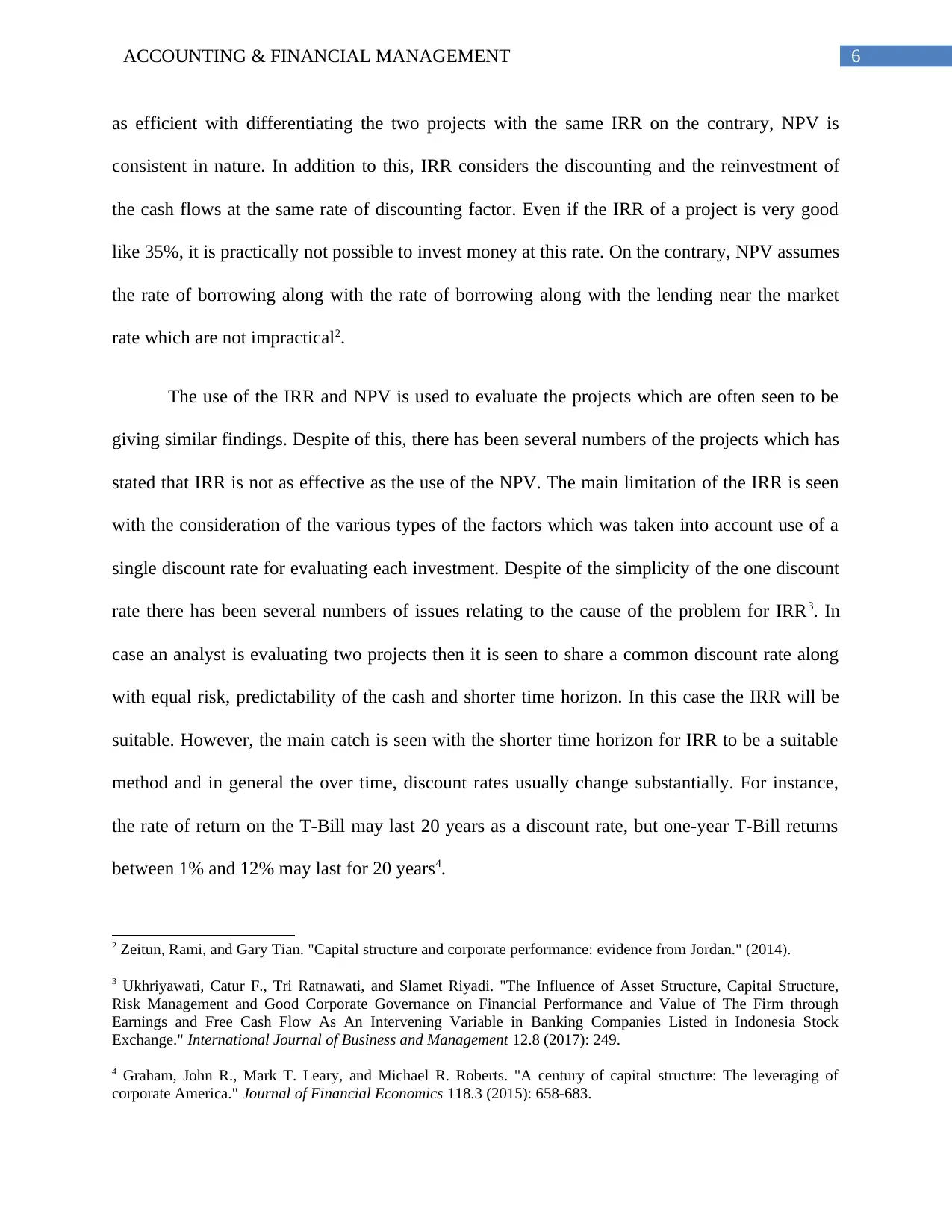
6ACCOUNTING & FINANCIAL MANAGEMENT
as efficient with differentiating the two projects with the same IRR on the contrary, NPV is
consistent in nature. In addition to this, IRR considers the discounting and the reinvestment of
the cash flows at the same rate of discounting factor. Even if the IRR of a project is very good
like 35%, it is practically not possible to invest money at this rate. On the contrary, NPV assumes
the rate of borrowing along with the rate of borrowing along with the lending near the market
rate which are not impractical2.
The use of the IRR and NPV is used to evaluate the projects which are often seen to be
giving similar findings. Despite of this, there has been several numbers of the projects which has
stated that IRR is not as effective as the use of the NPV. The main limitation of the IRR is seen
with the consideration of the various types of the factors which was taken into account use of a
single discount rate for evaluating each investment. Despite of the simplicity of the one discount
rate there has been several numbers of issues relating to the cause of the problem for IRR3. In
case an analyst is evaluating two projects then it is seen to share a common discount rate along
with equal risk, predictability of the cash and shorter time horizon. In this case the IRR will be
suitable. However, the main catch is seen with the shorter time horizon for IRR to be a suitable
method and in general the over time, discount rates usually change substantially. For instance,
the rate of return on the T-Bill may last 20 years as a discount rate, but one-year T-Bill returns
between 1% and 12% may last for 20 years4.
2 Zeitun, Rami, and Gary Tian. "Capital structure and corporate performance: evidence from Jordan." (2014).
3 Ukhriyawati, Catur F., Tri Ratnawati, and Slamet Riyadi. "The Influence of Asset Structure, Capital Structure,
Risk Management and Good Corporate Governance on Financial Performance and Value of The Firm through
Earnings and Free Cash Flow As An Intervening Variable in Banking Companies Listed in Indonesia Stock
Exchange." International Journal of Business and Management 12.8 (2017): 249.
4 Graham, John R., Mark T. Leary, and Michael R. Roberts. "A century of capital structure: The leveraging of
corporate America." Journal of Financial Economics 118.3 (2015): 658-683.
as efficient with differentiating the two projects with the same IRR on the contrary, NPV is
consistent in nature. In addition to this, IRR considers the discounting and the reinvestment of
the cash flows at the same rate of discounting factor. Even if the IRR of a project is very good
like 35%, it is practically not possible to invest money at this rate. On the contrary, NPV assumes
the rate of borrowing along with the rate of borrowing along with the lending near the market
rate which are not impractical2.
The use of the IRR and NPV is used to evaluate the projects which are often seen to be
giving similar findings. Despite of this, there has been several numbers of the projects which has
stated that IRR is not as effective as the use of the NPV. The main limitation of the IRR is seen
with the consideration of the various types of the factors which was taken into account use of a
single discount rate for evaluating each investment. Despite of the simplicity of the one discount
rate there has been several numbers of issues relating to the cause of the problem for IRR3. In
case an analyst is evaluating two projects then it is seen to share a common discount rate along
with equal risk, predictability of the cash and shorter time horizon. In this case the IRR will be
suitable. However, the main catch is seen with the shorter time horizon for IRR to be a suitable
method and in general the over time, discount rates usually change substantially. For instance,
the rate of return on the T-Bill may last 20 years as a discount rate, but one-year T-Bill returns
between 1% and 12% may last for 20 years4.
2 Zeitun, Rami, and Gary Tian. "Capital structure and corporate performance: evidence from Jordan." (2014).
3 Ukhriyawati, Catur F., Tri Ratnawati, and Slamet Riyadi. "The Influence of Asset Structure, Capital Structure,
Risk Management and Good Corporate Governance on Financial Performance and Value of The Firm through
Earnings and Free Cash Flow As An Intervening Variable in Banking Companies Listed in Indonesia Stock
Exchange." International Journal of Business and Management 12.8 (2017): 249.
4 Graham, John R., Mark T. Leary, and Michael R. Roberts. "A century of capital structure: The leveraging of
corporate America." Journal of Financial Economics 118.3 (2015): 658-683.
Paraphrase This Document
Need a fresh take? Get an instant paraphrase of this document with our AI Paraphraser
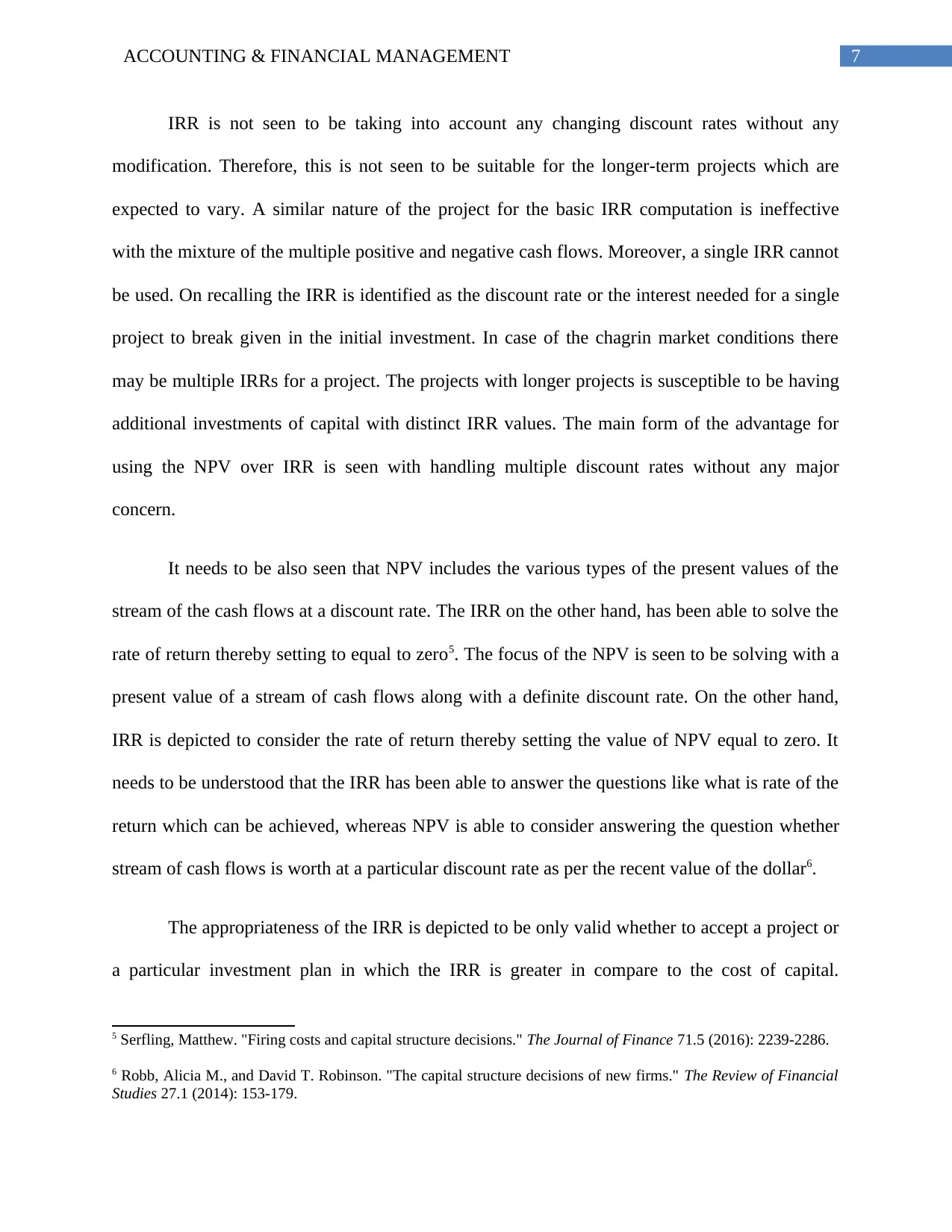
7ACCOUNTING & FINANCIAL MANAGEMENT
IRR is not seen to be taking into account any changing discount rates without any
modification. Therefore, this is not seen to be suitable for the longer-term projects which are
expected to vary. A similar nature of the project for the basic IRR computation is ineffective
with the mixture of the multiple positive and negative cash flows. Moreover, a single IRR cannot
be used. On recalling the IRR is identified as the discount rate or the interest needed for a single
project to break given in the initial investment. In case of the chagrin market conditions there
may be multiple IRRs for a project. The projects with longer projects is susceptible to be having
additional investments of capital with distinct IRR values. The main form of the advantage for
using the NPV over IRR is seen with handling multiple discount rates without any major
concern.
It needs to be also seen that NPV includes the various types of the present values of the
stream of the cash flows at a discount rate. The IRR on the other hand, has been able to solve the
rate of return thereby setting to equal to zero5. The focus of the NPV is seen to be solving with a
present value of a stream of cash flows along with a definite discount rate. On the other hand,
IRR is depicted to consider the rate of return thereby setting the value of NPV equal to zero. It
needs to be understood that the IRR has been able to answer the questions like what is rate of the
return which can be achieved, whereas NPV is able to consider answering the question whether
stream of cash flows is worth at a particular discount rate as per the recent value of the dollar6.
The appropriateness of the IRR is depicted to be only valid whether to accept a project or
a particular investment plan in which the IRR is greater in compare to the cost of capital.
5 Serfling, Matthew. "Firing costs and capital structure decisions." The Journal of Finance 71.5 (2016): 2239-2286.
6 Robb, Alicia M., and David T. Robinson. "The capital structure decisions of new firms." The Review of Financial
Studies 27.1 (2014): 153-179.
IRR is not seen to be taking into account any changing discount rates without any
modification. Therefore, this is not seen to be suitable for the longer-term projects which are
expected to vary. A similar nature of the project for the basic IRR computation is ineffective
with the mixture of the multiple positive and negative cash flows. Moreover, a single IRR cannot
be used. On recalling the IRR is identified as the discount rate or the interest needed for a single
project to break given in the initial investment. In case of the chagrin market conditions there
may be multiple IRRs for a project. The projects with longer projects is susceptible to be having
additional investments of capital with distinct IRR values. The main form of the advantage for
using the NPV over IRR is seen with handling multiple discount rates without any major
concern.
It needs to be also seen that NPV includes the various types of the present values of the
stream of the cash flows at a discount rate. The IRR on the other hand, has been able to solve the
rate of return thereby setting to equal to zero5. The focus of the NPV is seen to be solving with a
present value of a stream of cash flows along with a definite discount rate. On the other hand,
IRR is depicted to consider the rate of return thereby setting the value of NPV equal to zero. It
needs to be understood that the IRR has been able to answer the questions like what is rate of the
return which can be achieved, whereas NPV is able to consider answering the question whether
stream of cash flows is worth at a particular discount rate as per the recent value of the dollar6.
The appropriateness of the IRR is depicted to be only valid whether to accept a project or
a particular investment plan in which the IRR is greater in compare to the cost of capital.
5 Serfling, Matthew. "Firing costs and capital structure decisions." The Journal of Finance 71.5 (2016): 2239-2286.
6 Robb, Alicia M., and David T. Robinson. "The capital structure decisions of new firms." The Review of Financial
Studies 27.1 (2014): 153-179.
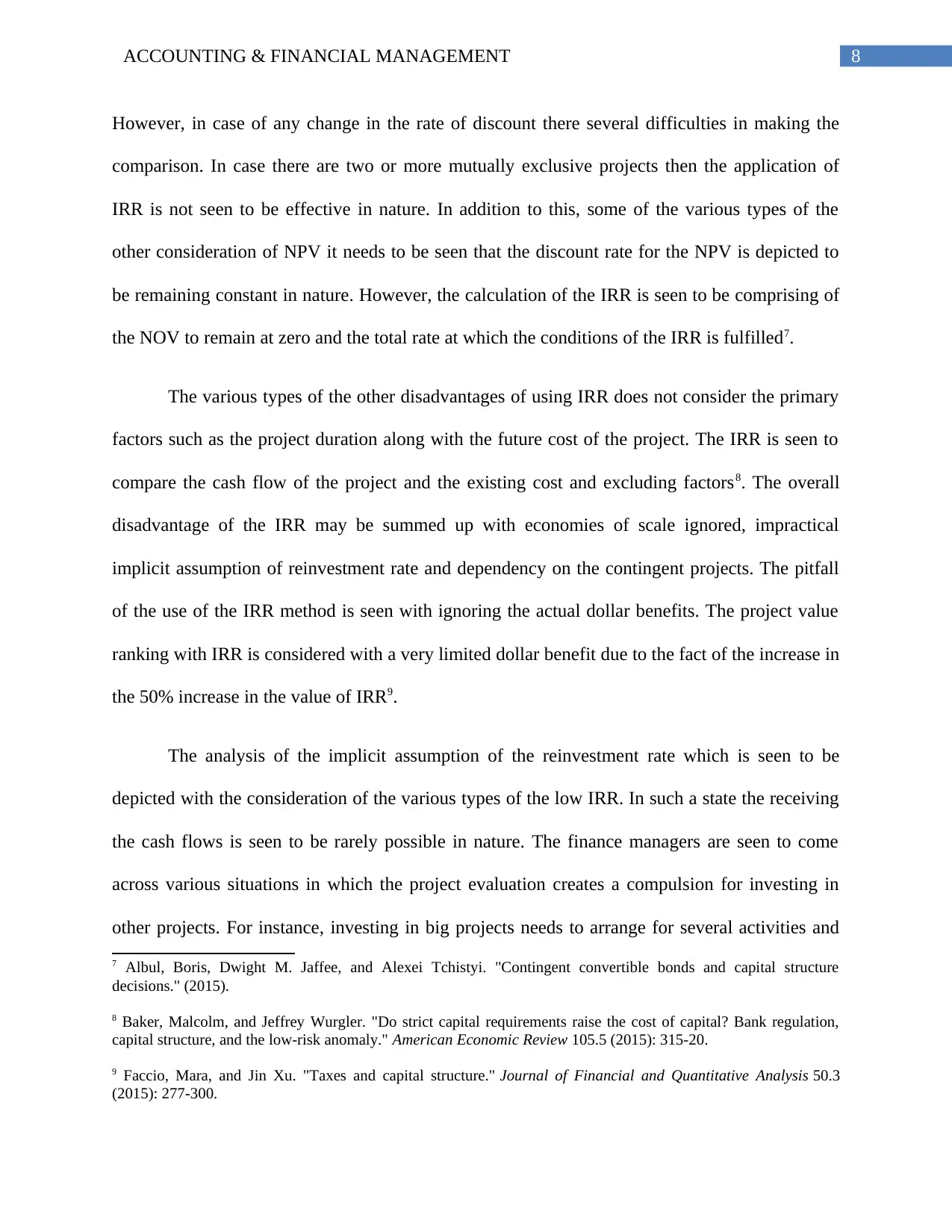
8ACCOUNTING & FINANCIAL MANAGEMENT
However, in case of any change in the rate of discount there several difficulties in making the
comparison. In case there are two or more mutually exclusive projects then the application of
IRR is not seen to be effective in nature. In addition to this, some of the various types of the
other consideration of NPV it needs to be seen that the discount rate for the NPV is depicted to
be remaining constant in nature. However, the calculation of the IRR is seen to be comprising of
the NOV to remain at zero and the total rate at which the conditions of the IRR is fulfilled7.
The various types of the other disadvantages of using IRR does not consider the primary
factors such as the project duration along with the future cost of the project. The IRR is seen to
compare the cash flow of the project and the existing cost and excluding factors8. The overall
disadvantage of the IRR may be summed up with economies of scale ignored, impractical
implicit assumption of reinvestment rate and dependency on the contingent projects. The pitfall
of the use of the IRR method is seen with ignoring the actual dollar benefits. The project value
ranking with IRR is considered with a very limited dollar benefit due to the fact of the increase in
the 50% increase in the value of IRR9.
The analysis of the implicit assumption of the reinvestment rate which is seen to be
depicted with the consideration of the various types of the low IRR. In such a state the receiving
the cash flows is seen to be rarely possible in nature. The finance managers are seen to come
across various situations in which the project evaluation creates a compulsion for investing in
other projects. For instance, investing in big projects needs to arrange for several activities and
7 Albul, Boris, Dwight M. Jaffee, and Alexei Tchistyi. "Contingent convertible bonds and capital structure
decisions." (2015).
8 Baker, Malcolm, and Jeffrey Wurgler. "Do strict capital requirements raise the cost of capital? Bank regulation,
capital structure, and the low-risk anomaly." American Economic Review 105.5 (2015): 315-20.
9 Faccio, Mara, and Jin Xu. "Taxes and capital structure." Journal of Financial and Quantitative Analysis 50.3
(2015): 277-300.
However, in case of any change in the rate of discount there several difficulties in making the
comparison. In case there are two or more mutually exclusive projects then the application of
IRR is not seen to be effective in nature. In addition to this, some of the various types of the
other consideration of NPV it needs to be seen that the discount rate for the NPV is depicted to
be remaining constant in nature. However, the calculation of the IRR is seen to be comprising of
the NOV to remain at zero and the total rate at which the conditions of the IRR is fulfilled7.
The various types of the other disadvantages of using IRR does not consider the primary
factors such as the project duration along with the future cost of the project. The IRR is seen to
compare the cash flow of the project and the existing cost and excluding factors8. The overall
disadvantage of the IRR may be summed up with economies of scale ignored, impractical
implicit assumption of reinvestment rate and dependency on the contingent projects. The pitfall
of the use of the IRR method is seen with ignoring the actual dollar benefits. The project value
ranking with IRR is considered with a very limited dollar benefit due to the fact of the increase in
the 50% increase in the value of IRR9.
The analysis of the implicit assumption of the reinvestment rate which is seen to be
depicted with the consideration of the various types of the low IRR. In such a state the receiving
the cash flows is seen to be rarely possible in nature. The finance managers are seen to come
across various situations in which the project evaluation creates a compulsion for investing in
other projects. For instance, investing in big projects needs to arrange for several activities and
7 Albul, Boris, Dwight M. Jaffee, and Alexei Tchistyi. "Contingent convertible bonds and capital structure
decisions." (2015).
8 Baker, Malcolm, and Jeffrey Wurgler. "Do strict capital requirements raise the cost of capital? Bank regulation,
capital structure, and the low-risk anomaly." American Economic Review 105.5 (2015): 315-20.
9 Faccio, Mara, and Jin Xu. "Taxes and capital structure." Journal of Financial and Quantitative Analysis 50.3
(2015): 277-300.

9ACCOUNTING & FINANCIAL MANAGEMENT
these projects are dependent with the contingent projects which is to be considered by the
manager10.
10 Allen, Franklin, Elena Carletti, and Robert Marquez. "Deposits and bank capital structure." Journal of Financial
Economics118.3 (2015): 601-619.
these projects are dependent with the contingent projects which is to be considered by the
manager10.
10 Allen, Franklin, Elena Carletti, and Robert Marquez. "Deposits and bank capital structure." Journal of Financial
Economics118.3 (2015): 601-619.
Secure Best Marks with AI Grader
Need help grading? Try our AI Grader for instant feedback on your assignments.
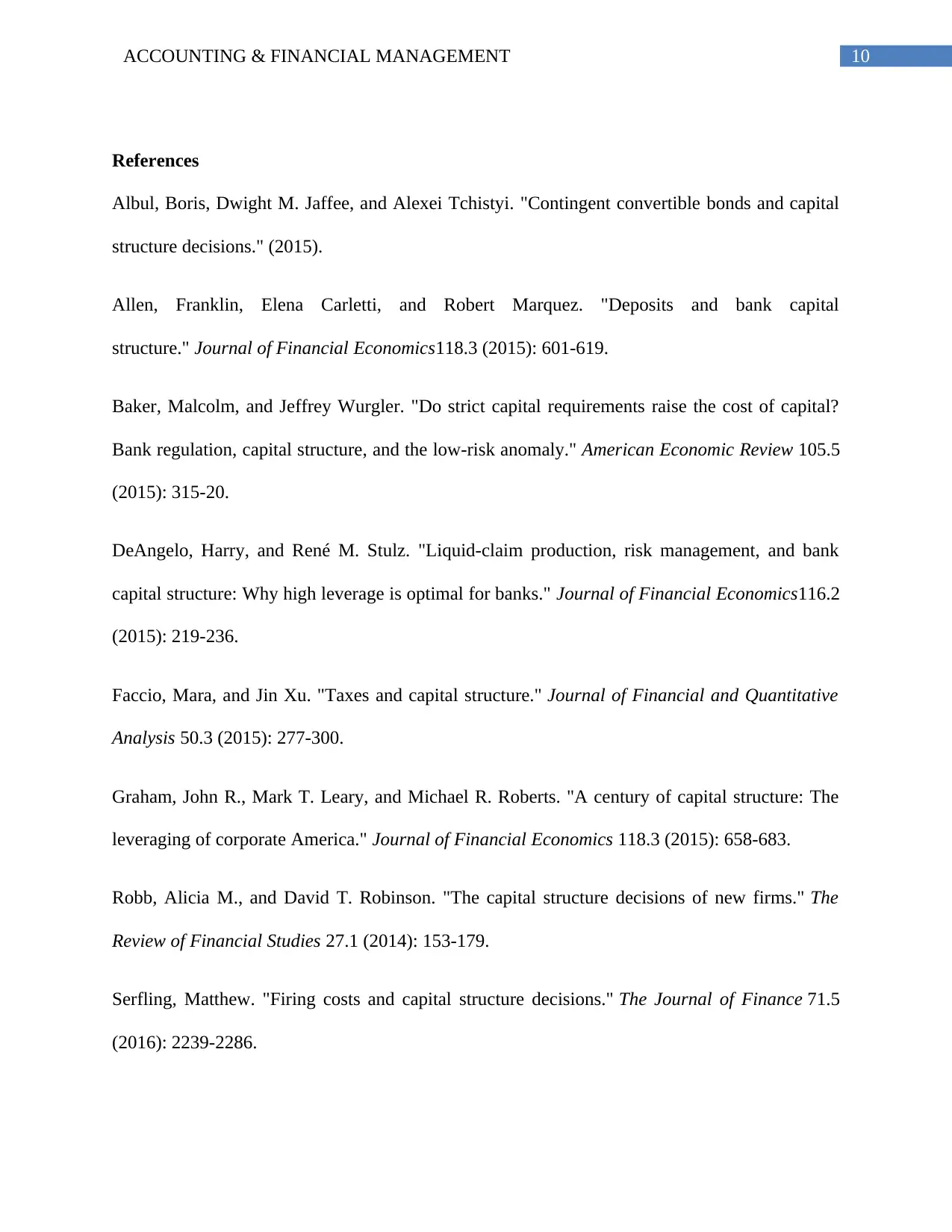
10ACCOUNTING & FINANCIAL MANAGEMENT
References
Albul, Boris, Dwight M. Jaffee, and Alexei Tchistyi. "Contingent convertible bonds and capital
structure decisions." (2015).
Allen, Franklin, Elena Carletti, and Robert Marquez. "Deposits and bank capital
structure." Journal of Financial Economics118.3 (2015): 601-619.
Baker, Malcolm, and Jeffrey Wurgler. "Do strict capital requirements raise the cost of capital?
Bank regulation, capital structure, and the low-risk anomaly." American Economic Review 105.5
(2015): 315-20.
DeAngelo, Harry, and René M. Stulz. "Liquid-claim production, risk management, and bank
capital structure: Why high leverage is optimal for banks." Journal of Financial Economics116.2
(2015): 219-236.
Faccio, Mara, and Jin Xu. "Taxes and capital structure." Journal of Financial and Quantitative
Analysis 50.3 (2015): 277-300.
Graham, John R., Mark T. Leary, and Michael R. Roberts. "A century of capital structure: The
leveraging of corporate America." Journal of Financial Economics 118.3 (2015): 658-683.
Robb, Alicia M., and David T. Robinson. "The capital structure decisions of new firms." The
Review of Financial Studies 27.1 (2014): 153-179.
Serfling, Matthew. "Firing costs and capital structure decisions." The Journal of Finance 71.5
(2016): 2239-2286.
References
Albul, Boris, Dwight M. Jaffee, and Alexei Tchistyi. "Contingent convertible bonds and capital
structure decisions." (2015).
Allen, Franklin, Elena Carletti, and Robert Marquez. "Deposits and bank capital
structure." Journal of Financial Economics118.3 (2015): 601-619.
Baker, Malcolm, and Jeffrey Wurgler. "Do strict capital requirements raise the cost of capital?
Bank regulation, capital structure, and the low-risk anomaly." American Economic Review 105.5
(2015): 315-20.
DeAngelo, Harry, and René M. Stulz. "Liquid-claim production, risk management, and bank
capital structure: Why high leverage is optimal for banks." Journal of Financial Economics116.2
(2015): 219-236.
Faccio, Mara, and Jin Xu. "Taxes and capital structure." Journal of Financial and Quantitative
Analysis 50.3 (2015): 277-300.
Graham, John R., Mark T. Leary, and Michael R. Roberts. "A century of capital structure: The
leveraging of corporate America." Journal of Financial Economics 118.3 (2015): 658-683.
Robb, Alicia M., and David T. Robinson. "The capital structure decisions of new firms." The
Review of Financial Studies 27.1 (2014): 153-179.
Serfling, Matthew. "Firing costs and capital structure decisions." The Journal of Finance 71.5
(2016): 2239-2286.
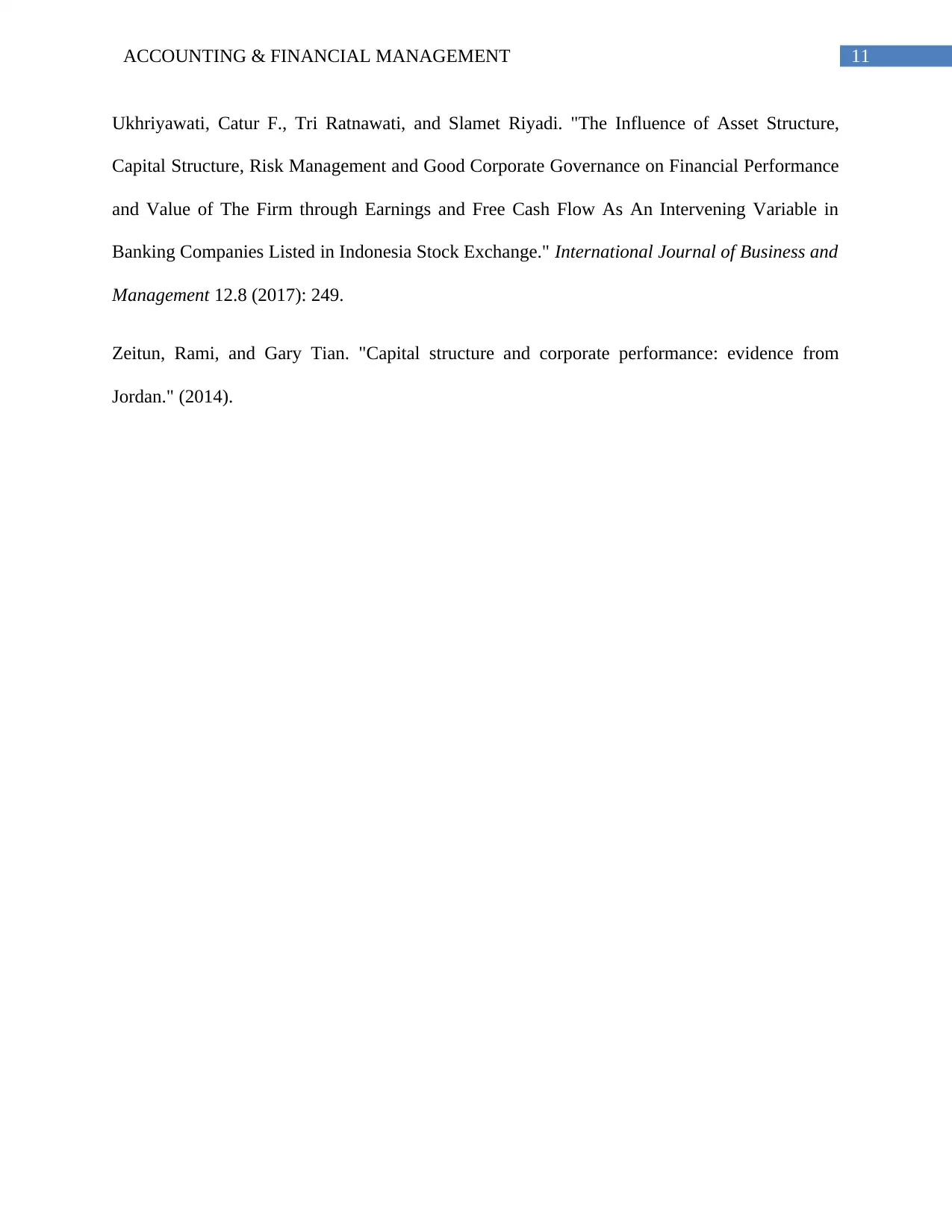
11ACCOUNTING & FINANCIAL MANAGEMENT
Ukhriyawati, Catur F., Tri Ratnawati, and Slamet Riyadi. "The Influence of Asset Structure,
Capital Structure, Risk Management and Good Corporate Governance on Financial Performance
and Value of The Firm through Earnings and Free Cash Flow As An Intervening Variable in
Banking Companies Listed in Indonesia Stock Exchange." International Journal of Business and
Management 12.8 (2017): 249.
Zeitun, Rami, and Gary Tian. "Capital structure and corporate performance: evidence from
Jordan." (2014).
Ukhriyawati, Catur F., Tri Ratnawati, and Slamet Riyadi. "The Influence of Asset Structure,
Capital Structure, Risk Management and Good Corporate Governance on Financial Performance
and Value of The Firm through Earnings and Free Cash Flow As An Intervening Variable in
Banking Companies Listed in Indonesia Stock Exchange." International Journal of Business and
Management 12.8 (2017): 249.
Zeitun, Rami, and Gary Tian. "Capital structure and corporate performance: evidence from
Jordan." (2014).
1 out of 12
Related Documents
Your All-in-One AI-Powered Toolkit for Academic Success.
+13062052269
info@desklib.com
Available 24*7 on WhatsApp / Email
![[object Object]](/_next/static/media/star-bottom.7253800d.svg)
Unlock your academic potential
© 2024 | Zucol Services PVT LTD | All rights reserved.




